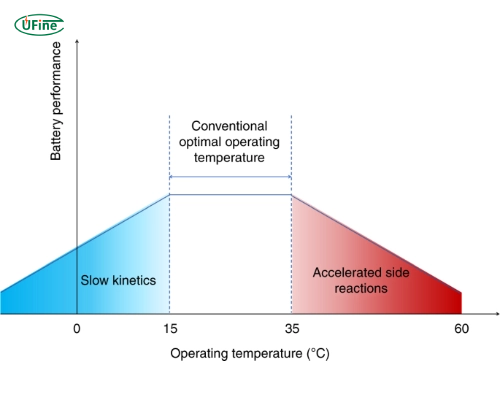In today’s world, Li-ion batteries power many things like phones and cars. People need to know how temperature affects these batteries. This guide tells you the best temperature range for Li-ion batteries, what affects their temperature, how temperature affects their performance, and tips for keeping them cool.
Part 1. Ideal lithium-ion battery operating temperature range
Li-ion batteries function optimally within a specific temperature range. The ideal operating temperature depends on the particular chemistry and design of the battery but generally falls between 15°C and 25°C (59°F and 77°F). This temperature range ensures the highest efficiency, capacity, and battery performance. Operating the battery within this optimal range extends its lifespan. It minimizes the risk of safety issues, such as thermal runaway or reduced capacity.
Part 2. Factors influencing li-ion battery operating temperatures
Several factors influence the operating temperatures of Li-ion batteries. Understanding these factors is crucial for effectively managing battery temperature.
- 1. Ambient Temperature
The ambient temperature, or the temperature of the surrounding environment, plays a significant role in Li-ion battery performance. Extreme hot or cold temperatures can adversely affect the battery’s efficiency, capacity, and lifespan. High temperatures accelerate the battery’s aging process, causing capacity degradation and reducing lifespan. Similarly, extremely low temperatures can hinder the battery’s ability to deliver power effectively.
- 2. Discharge/Charge Rate
The discharge or charge rate of a Li-ion battery affects its operating temperature. Rapid charging or discharging generates more heat within the battery, elevating its temperature. While Li-ion batteries can handle moderate discharge and charge rates without significant temperature fluctuations, extreme rates can lead to thermal stress and affect the battery’s longevity.
- 3. Battery Design and Chemistry
The design and chemistry of a Li-ion battery can impact its operating temperature range. Different battery chemistries have varying temperature sensitivities. Some chemistries, such as Lithium Iron Phosphate (LiFePO4), exhibit improved thermal stability. Additionally, the battery’s design, including the arrangement and size of its cells, influences its ability to dissipate heat effectively.
- 4. Ventilation and Cooling Systems
The presence of proper ventilation and cooling systems in devices using Li-ion batteries can help regulate their operating temperatures. Ventilation allows the dissipation of heat generated during battery operation, preventing excessive temperature rise. Cooling systems, such as heat sinks or fans, further aid in maintaining optimal temperature conditions for the battery.
Part 3. Effects of temperature on li-ion battery performance
Temperature has a profound impact on the performance and lifespan of Li-ion batteries. Here are some notable effects of temperature on battery operation:
- 1. Capacity and Efficiency
High temperatures accelerate the chemical reactions within the battery, increasing its self-discharge rate and reducing its overall capacity. On the other hand, low temperatures slow the reactions, limiting the battery’s ability to deliver power effectively. Operating the battery within the ideal temperature range ensures maximum capacity and efficiency.
- 2. Lifespan and Aging
Temperature dramatically influences the aging process of Li-ion batteries. Exposure to high temperatures causes accelerated degradation of the battery’s active materials, reducing capacity over time. Conversely, lower temperatures slow the aging process, prolonging the battery’s lifespan. By maintaining the battery within the optimal temperature range, you can extend its overall longevity.
- 3. Safety Concerns
Extreme temperatures pose safety risks for Li-ion batteries. High temperatures can increase the likelihood of thermal runaway, where the battery temperature rises uncontrollably, potentially leading to fires or explosions. Low temperatures, however, can cause the battery’s electrolyte to freeze, resulting in irreversible damage to the battery. Adhering to the recommended temperature range ensures safer battery operation.
Part 4. Tips for managing li-ion battery operating temperatures
To ensure optimal performance and longevity of Li-ion batteries, effectively managing their operating temperatures is essential.
- 1. Avoid Extreme Temperatures
Minimize exposing Li-ion batteries to extreme temperatures, both hot and cold. Avoid leaving devices with Li-ion batteries under direct sunlight or in freezing conditions for extended periods. Optimal storage conditions for unused batteries usually range between 15°C and 25°C (59°F and 77°F).
- 2. Moderate Discharge/Charge Rates
Avoid rapid charging or discharging of Li-ion batteries whenever possible. Moderate discharge and charge rates reduce heat generation, helping to maintain stable operating temperatures. If fast charging is necessary, ensure your device or charger has a specific design to handle it without causing excessive temperature rise.
- 3. Provide Adequate Ventilation
Ensure that devices housing Li-ion batteries have proper ventilation to allow heat dissipation. Avoid covering or obstructing the ventilation outlets of devices, as this can trap heat and elevate the battery’s operating temperature.
- 4. Implement Cooling Measures
Consider implementing additional cooling measures for devices that undergo heavy usage or experience high ambient temperatures. Regulate the battery’s temperature and prevent overheating actively by using heat sinks, fans, or other cooling systems.
- 5. Regular Maintenance and Inspection
Perform regular maintenance and inspection of devices with Li-ion batteries. Check for any signs of overheating, such as unusual warmth or bulging batteries, and address the issue promptly. Replace damaged or degraded batteries to ensure optimal performance and safety.
- 6. Optimize Charging and Discharging Times
Tryid charges Li-ion batteries to 100% or regularly discharges them to 0%. Keeping the battery’s charge level between 20% and 80% benefits its lifespan and temperature management.
- 7. Utilize Battery Management Systems
Devices equipped with battery management systems (BMS) can help monitor and regulate the operating temperature of Li-ion batteries. BMS can protect temperature, prevent overcharging or over-discharging, and ensure safe and efficient battery operation.
Part 5. Conclusion
Knowing and controlling how hot Li-ion batteries get is super important to make them work their best and last a long time. You can ensure your batteries work great and stay safe by keeping them in the proper temperature range, letting air circulate them, and not letting them get too hot or cold. So, remember, keeping the temperature just right is how you make your batteries work their best!
Part 6. FAQs
-
What temperature is wrong for lithium-ion batteries?
Temperatures above 60°C (140°F) generally harm lithium-ion batteries. -
What is the critical temperature for a lithium battery?
The critical temperature for a lithium battery is typically around 80°C (176°F), beyond which it can lead to thermal runaway and pose safety hazards. -
What is the temperature efficiency of a lithium-ion battery?
The temperature efficiency of a lithium-ion battery refers to its ability to maintain optimal performance within a specific temperature range, typically between 15°C to 35°C (59°F to 95°F). -
Is 40°C too hot for a battery?
Yes, 40°C (104°F) is approaching temperatures that can negatively impact lithium-ion battery performance and longevity. It’s advisable to avoid prolonged exposure to such high temperatures.
Related Tags:
More Articles

LiPo Battery Discharge Rate Guide & Calculation Tips
Understand LiPo battery discharge rates, C-ratings, and how to calculate max current. Essential guide for RC, drones, and electronics users.
High‑Capacity 3S LiPo Batteries: 5000 mAh vs. 10000 mAh
Compare 3S LiPo 5000mAh vs 10000mAh batteries by weight, power, and use. Find the best fit for your drone, RC car, or boat setup.
Top 5 Applications for Small 3S LiPo Batteries
Small 3S LiPo batteries power drones, RC gear, wearables, and robotics with high energy and low weight. Making them ideal for compact electronics projects.
Building and Charging Your Own 3S LiPo Pack: A Step‑by‑Step Guide
Learn how to build, balance, and charge a 3S LiPo battery pack safely at home with this complete DIY guide for hobbyists and beginners.
How to Choose the Right LiPo Battery Plug Type?
Discover the best LiPo battery plug types, how to choose them, and expert tips for safe usage, soldering, and maintenance.




